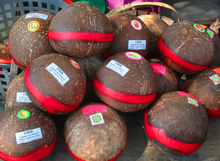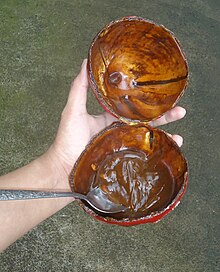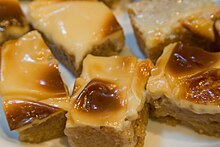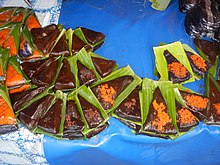Kalamay
 | |
| Alternative names | Calamay |
|---|---|
| Course | Dessert |
| Place of origin | Philippines |
| Region or state | Visayas,Luzon |
| Serving temperature | Hot, room temperature, cold |
| Main ingredients | Coconut milk,glutinous rice,brown sugar |
| Variations | Biko |

Kalamay(also spelledCalamay,literally "sugar" ) is a sticky sweet delicacy that is popular in many regions of thePhilippines.It is made ofcoconut milk,brown sugar,and groundglutinous rice.It can also be flavored withmargarine,peanut butter,orvanilla.Kalamaycan be eaten alone; but is usually used as a sweetener for a number ofFilipinodessertsand beverages. It is related to theChamorrodessert calledKalamai.
Preparation[edit]
Kalamayis made by extractingcoconut milkfrom grated coconuts twice. Glutinous rice is added to the first batch of coconut milk and the mixture is ground into a paste.Brown sugaris added to the second batch of coconut milk and boiled for several hours to makelatík.The mixture of ground glutinous rice and coconut milk is then poured into thelatíkand stirred until the consistency becomes very thick. It can be served hot or at room temperature especially when eaten with other dishes. ViscousKalamayare often served cooled to make it less runny and easier to eat.
Consumption[edit]
Kalamayis a popularpasalubong(theFilipinotradition of a homecoming gift). They are often eaten alone, directly from the packaging.[1]Kalamayis also used in a variety of traditional Filipino dishes as a sweetener,[2]including thesumanand thebukayo.It can also be added to beverages like coffee, milk, or hot chocolate.
Bikoandsinukmaniare similar dishes which use wholeglutinous ricegrains. The preparation is the same except that the glutinous rice is first cooked whole and not ground into a paste, and then is smothered with thelatík.In some regions (particularly in theNorthern Philippines), this dish is referred to as thekalamay,with the viscous kind differentiated as thekalamay-hati.
Thelatíkfromkalamayby itself can be used with other desserts, particularly with dishes made fromcassava(which is then referred to as 'cassavakalamay'). Kalamay is also commonly confused withmatamis sa bao,a similar viscous dish. However, the latter does not use rice.

Types[edit]


There are many variations and types of kalamay. Kalamay can be divided roughly into two types: the syrupy kind used in conjunction with other dishes (higherlatikratio), and the gummy chewy kind which is more expensive and usually eaten on its own.[1]
- Antipolokalamay(also calledkalamay perya) – theTagalogversion ofkalamay.It is a specialty ofAntipolo.It is traditionally served as a flat disk on banana leaves, topped withlatikcurds. It has a denser chewier texture.[3]
- Boholkalamay–kalamayfrom the island ofBoholcan vary from extremely sweet to mildly sweet. It is distinctive for being sold inside halved smooth coconut shells (themesocarpof coconuts, locally known asbagolorpaya). These containers are then sealed shut with a characteristic red crepe paper (papel de japon).[1]This type of packaging is known askalamay-hati(literally 'Half kalamay').[4]A type of Bohol Kalamay is called "Calamay sa Jagna" which is a famous delicacy from the town of Jagna. It has a distinct taste. The "Calamay sa Jagna" was taught intentionally by a parish priest of Jagna named Rev.Fr. Mariano Gutierrez of the Order of the Augustinian Recollects particularly in Barangay Can-upao.[5][6]

- BaguioKalamay– a type ofkalamayfromBaguio,Philippines. It is also known asSundot Kulangot(literally 'Picked Booger') because of its consistency. It is sweetened withmolasseswhich adds to its color. It is uniquely packed into halvedpitogo(Sago Palm of the genusCycas) shells and sealed with red crepe paper in a similar manner to the Boholkalamay.It is the smallest known traditional packaging ofkalamay.They are sold in bundles, several of thesekalamayballs are nestled inside split bamboo and tied with a string.[4]
- Iloilokalamay–kalamay(also known askalamay-hati) from the province ofIloiloand the island ofNegros.It is thicker in consistency than other types ofkalamay.The town ofSan Enriquecelebrates aKalamayFestival.[7]
- Candonkalamay–kalamayfromCandon,Ilocos Sur.[4]It is sold wrapped in banana leaves or in coconut shells, though modern packaging usespolystyrenecontainers wrapped incellophane.Candon also celebrates aKalamayFestival.
- Nilubyanoriniruban– a kind ofkalamaymade from pounded green rice. It originates fromCamiling, Tarlacin the Northern Philippines.[4]
- Mindorokalamay– a version ofkalamayfrom the island ofMindoro.It usually contains grated coconut and is flavored with peanut butter or vanilla.[4]
- Indangkalamay(also calledcalamay buna) – is a sweet delicacy of sticky rice, brown sugar and coconut milk that is well known inIndangCavite. This variety of calamay fromIndangis made from glutinous pulverized rice calledmalagkitmixed with coconut milk andpanutsa(nativejaggery).[8]
Similar to other traditionalkakaninrice cakes, kalamay also has variants based on secondary ingredients, they include:[9]
- Kalamay gabi– kalamay made withtaro(gabi). It is typically milky white in color.[10]
- Kalamay na pinpipig(also known askalamay na dumanorkalamay pandan) – kalamay flavored withpandan leafextracts and topped with toasted and pounded immature rice grains (pinipigorduman). It is bright green in color.[11][12]
- Kalamay ube– kalamay made with ube (purple yam). It is lavender or purple in color. It superficially resemblesube halaya,but has a smoother texture.[13][14]
Origin[edit]
Kalamay,in manyVisayan languages(particularlyHiligaynon), is synonymous with 'sugar' (extracted fromsugarcane).[15]The word is usuallyelidedtokamayin modernCebuanodialects. In theWaraylanguage,kalamayrefers to a hardened cake ofmolassesused as sweeteners for many cooked desserts. Its production has been known since theSpanishcolonization of the Philippines.
Similar desserts[edit]
A cousin of kalamay isdodol,found in Indonesia, Malaysia, Brunei, Singapore and in some parts of the Philippines. It uses similar basic ingredients and preparation.Dodol,however, is a solid candy, unlike the liquidkalamay.Kalamayis visually similar to the Chinesenian gao(also known astikoyin the Philippines), but they are not related.
See also[edit]
- Balikucha
- Binagol
- Coconut toffee
- Bukayo
- Coconut jam
- Dodol
- Espasol
- Kakanin
- Kalamai
- Latík
- Sapin-sapin
- Suman
- Wajik
References[edit]
- ^abc"Calamay from Bohol".marketmanila.com. June 22, 2010.RetrievedJanuary 7,2011.
- ^Vicente Labro (November 18, 2006)."'Kalamay'-making survives high-tech sugar mills ".newsinfo.inquirer.net. Archived fromthe originalon February 22, 2013.RetrievedJanuary 7,2011.
- ^""Kalamay Antipolo" style. "Tagalog Kitchen.November 3, 2013.RetrievedMay 18,2019.
- ^abcdeEdgie B. Polistico (December 18, 2010)."Pinoy Food and Cooking Dictionary – C".EDGIE POLISTICO’S encyclopedic PINOY dictionary.philfoodcooking.blogspot.com.RetrievedJanuary 7,2011.
- ^"Jagna celebrates 190 year-old calamay tradition, April 28-30".The Bohol Chronicle.May 3, 2015.
- ^"Welcome to Jagna".
- ^"Municipality of San Enrique and theKalamayFestival ".iloilohangout.tigaswebs.com. 2008. Archived fromthe originalon July 17, 2011.RetrievedJanuary 7,2011.
- ^"Calamay Buna, a Sweet Delicacy from Indang, Cavite".wowcavite.com. 2011.RetrievedMarch 31,2015.
- ^"Kalamay".Ang Sarap.August 23, 2012.RetrievedMay 18,2019.
- ^"Kalamay Gabi".Kawaling Pinoy.February 10, 2019.RetrievedMay 18,2019.
- ^"Kalamay na Duman aka Kalamay na Pinipig (Green Sticky Rice Cake)".Masarap.ph.RetrievedMay 18,2019.
- ^Belen, Jun (June 20, 2012)."How to Make Kalamay na Pinipig (Pinipig Rice Cake)".Junblog.RetrievedMay 18,2019.
- ^"Ube Kalamay Recipe".Panlasang Pinoy.RetrievedMay 18,2019.
- ^"Ube Kalamay".Kawaling Pinoy.March 6, 2018.RetrievedMay 18,2019.
- ^Jenny B. Orillos (June 21, 2010)."Sweet and Sticky Pinoy Treats: Our Top 10 Kakanin".spot.ph. Archived fromthe originalon July 20, 2010.RetrievedJanuary 7,2011.
External links[edit]
![]() Media related toKalamayat Wikimedia Commons
Media related toKalamayat Wikimedia Commons

